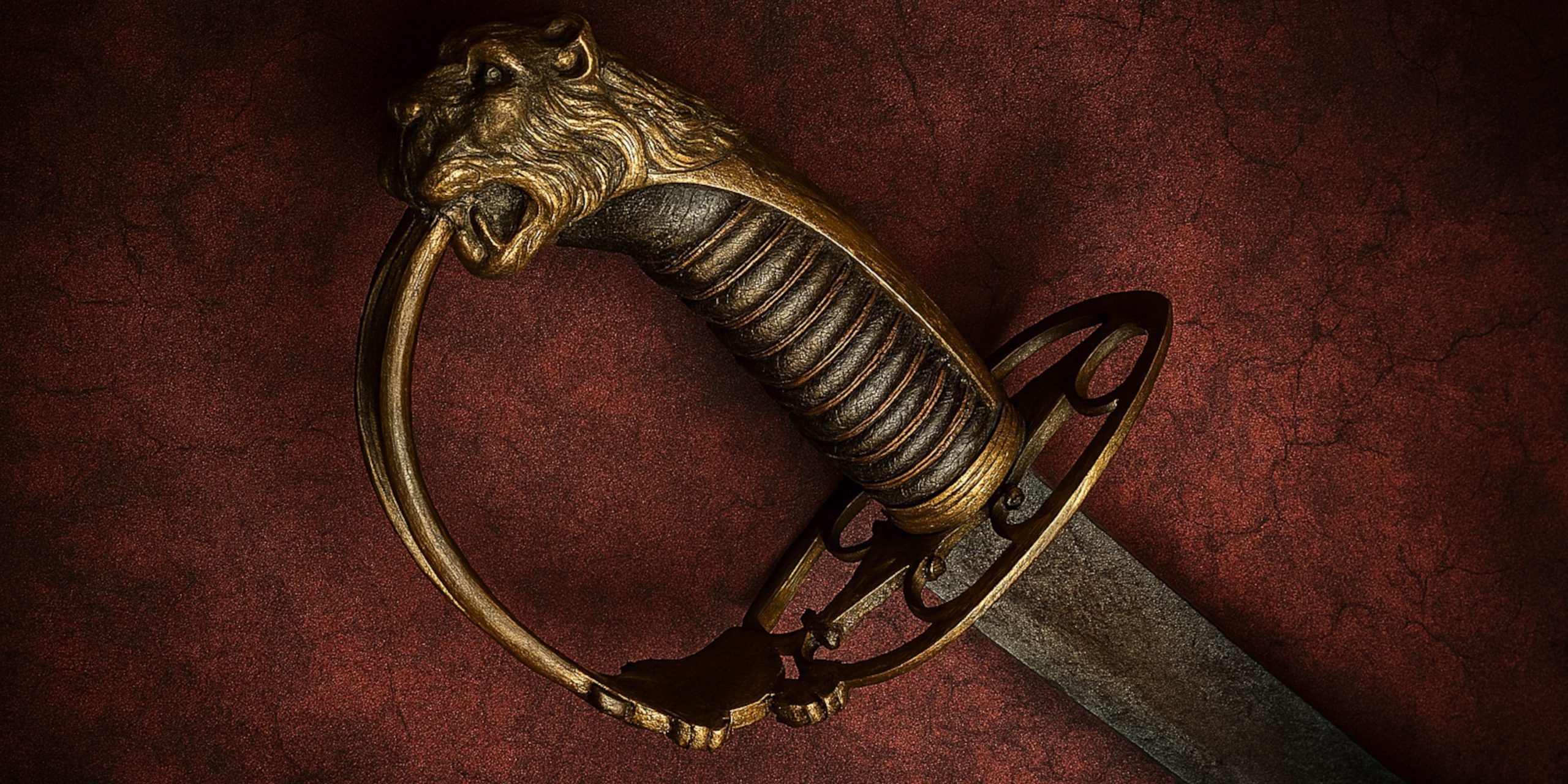
The British Pattern 1803 Infantry Sabre marked a significant shift in the arming of officers during the Napoleonic Wars. Introduced in the same year as the short-lived Peace of Amiens, it was conceived for use by officers of the light infantry and flank companies. Unlike the straight-bladed spadroon it partially replaced, the 1803 sabre was curved, more robust, and well-suited to the demands of active service, especially in colonial campaigns and field engagements. It became a favourite among officers seeking both utility and a symbol of martial flair.
Specification
| Feature | Detail |
|---|---|
| Blade Type | Curved, single-edged sabre |
| Blade Length | Approx. 32 to 33 inches (81 to 84 cm) |
| Blade Width | Around 1.2 inches at base |
| Hilt | Brass with lion-head pommel |
| Guard | Knucklebow with crown and GR cypher |
| Grip | Typically leather-covered wood with wire |
| Fullers | Single or multiple narrow fullers |
| Scabbard | Black leather with brass fittings |
| Weight | Approx. 1.9 to 2.4 lbs (0.85 to 1.1 kg) |
History and Evolution
The 1803 sabre emerged as part of broader reforms in British military equipment following experience in the American Revolutionary War and early Napoleonic campaigns. Officers had begun to demand more effective swords than the spadroons, which were often considered weak in combat.
The curved blade took inspiration from Eastern sabres, including Indian tulwars and Mameluke swords, both admired for their cutting power. The 1803 sabre retained a decorative flair typical of officer swords but was far more serviceable.
While not standard issue across all infantry units, it was popular in light companies, rifle regiments, and colonial forces. It was eventually supplanted by the 1822 Pattern Infantry Officer’s Sword, which featured a pipe-back blade and a more elaborate Gothic hilt, but the 1803 remained in use well into the 1820s.
Advantages and Disadvantages
Advantages:
- Better cutting power than the straight-bladed spadroon
- Robust and effective in close combat
- More practical for active campaigning
- Visually striking, with an imposing silhouette
Disadvantages:
- Less effective at thrusting compared to spadroons or later pipe-back swords
- Limited official regulation led to considerable variation in quality and form
- Heavier than many other officer swords, potentially fatiguing over prolonged use
Comparison with Similar Weapons
| Feature | Pattern 1803 Sabre | Pattern 1796 Light Cavalry Sabre | Spadroon (1796 Pattern) |
|---|---|---|---|
| Intended Users | Infantry Officers | Cavalry Troopers | Infantry Officers |
| Blade Type | Curved | Curved and broader | Straight, single-edged |
| Combat Role | Slashing, some thrusting | Primarily slashing | Mainly thrusting |
| Durability | Moderate to High | High | Often weak and brittle |
| Hilt Protection | Knucklebow only | Simple stirrup hilt | Straight guard, minimal |
| Status Symbol Value | High | Moderate | Moderate |
Legacy
The Pattern 1803 Sabre has become one of the more admired British swords of the Napoleonic period. Its blend of function and flourish, especially the elaborate hilts bearing royal cyphers, regimental badges, or patriotic symbols such as the crowned GR, made it a reflection of personal style and loyalty.
Surviving examples are often linked to notable figures and campaigns, including the Peninsular War and the British expedition to Egypt. Its legacy lies in how it bridged the gap between ornamental officer swords and true combat-ready weapons.
Where to See
You can find well-preserved examples of the Pattern 1803 Sabre in several major collections:
- National Army Museum, London: Houses officer swords from the Napoleonic Wars, including variants of the 1803.
- Royal Armouries, Leeds: Displays a range of military swords with contextual information on battlefield use.
- British Museum (Arms and Armour Section): Occasionally includes 1803s in temporary or rotating exhibitions.
- Imperial War Museum: Has representative samples of British military arms, though Napoleonic-era swords are less prominently displayed.
Collector’s Guide (Including Auction Prices)
Key Points for Collectors:
- Original examples often feature personalised etching or regimental insignia.
- Variants exist with differing blade lengths and hilt designs.
- Provenance significantly affects value.
- Watch for reproductions and refitted blades.
Estimated Prices (As of Recent Auctions):
| Condition | Description | Price Range (GBP) |
|---|---|---|
| Excellent with Provenance | Full etching, original scabbard, named owner | £2,500 to £4,000 |
| Good Condition | Some wear, minor repair or missing wire | £1,200 to £2,000 |
| Fair or Refitted | Replacement parts or poor finish | £500 to £1,000 |
Collectors often favour sabres linked to specific regiments or historical events. Documentation, such as officer service records or presentation inscriptions, can dramatically increase the desirability and price.



